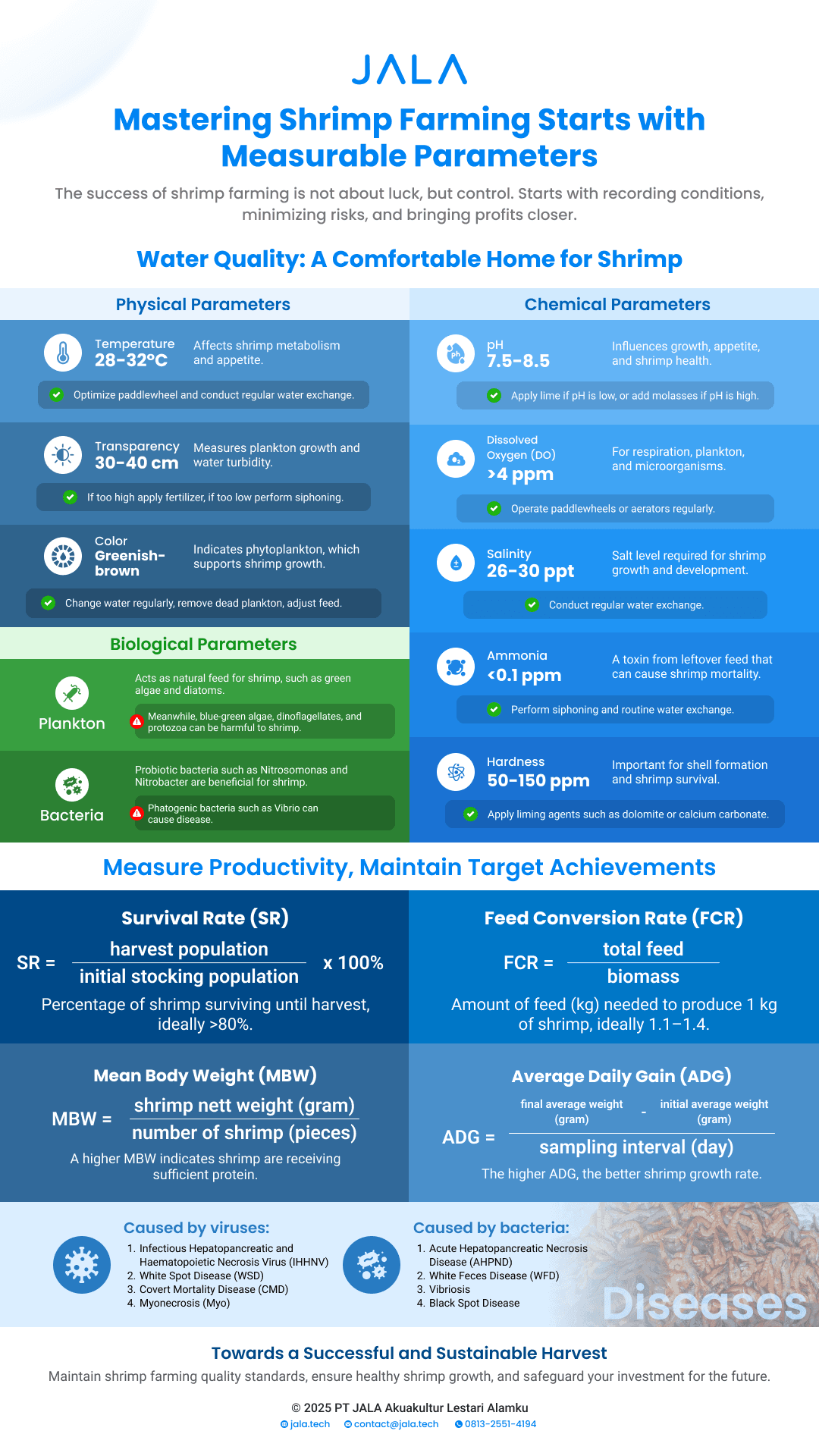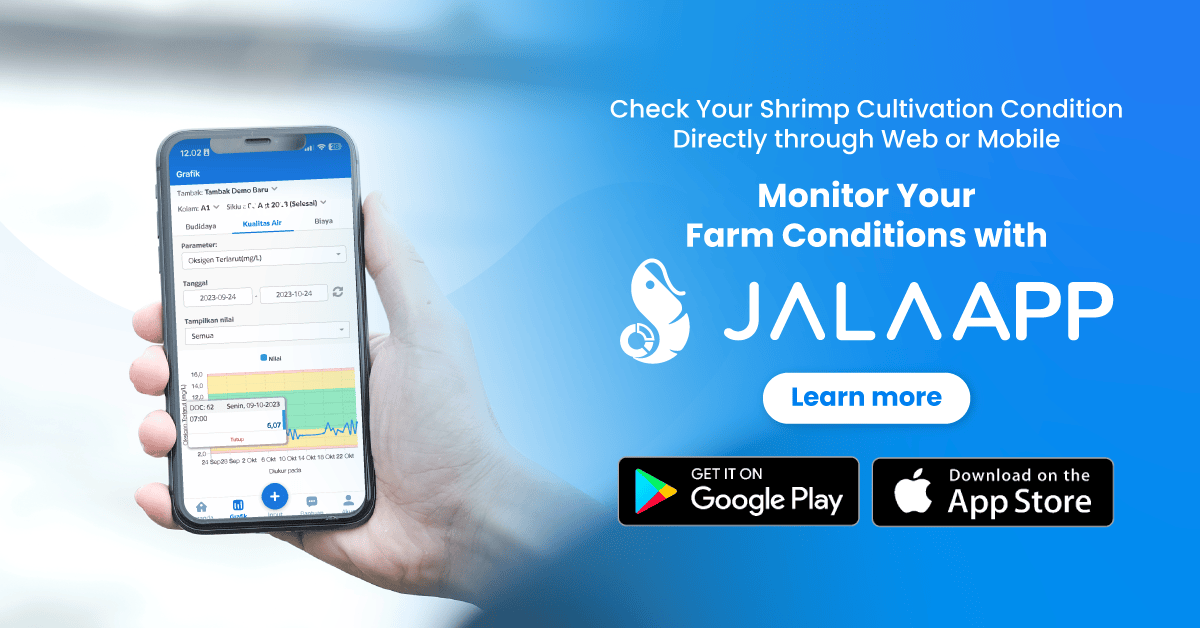
It is important for all farm personnel to know how to manage a vannamei shrimp farm properly. Knowing the right method will minimize problems in the farm and contribute to successful cultivation.
What are the criteria for a well-managed shrimp farm? How to manage a shrimp farm properly? Read the discussion below.
The Criteria for a Well-Managed Shrimp Farm
Before understanding how to manage a vannamei shrimp farm, you need to know the criteria for a well-managed farm. In Indonesia, this is elaborated in The Minister of Maritime Affairs and Fisheries Regulation No. 75 of 2016 regarding General Guidelines for Rearing Tiger Shrimp (Penaeus monodon) and Vannamei Shrimp (Litopenaeus vannamei) which has stated several criteria for a proper shrimp farm. Here are some of the important points:
- Have sufficient and high quality source water, rearing water, and soil.
- Separated pond water inlet and outlet.
- The ponds and water channels’ layouts are oriented to access high quality and disease-free water.
- The layout of pond infrastructure including pond dike is arranged to support cultivation efficiency.
- Cultivation facilities, including fry, feed, medicine, fertilizer, tools, and machines, used must meet the standards.
- Pond construction must be able to withstand the volume of water.
- Conducting proper environmental management, shrimp health control, biosecurity, waste management, harvesting, and documentation.
7 Measures for Managing A Shrimp Farm
There are at least 7 important measures you need to take in managing a shrimp farm. These seven measures include:
1. Cultivate with Adequate Stocking Density
The first way to manage a shrimp farm is to cultivate with adequate stocking density. It is best to adjust the stocking density to your financial capabilities, in this case the capital you have, to avoid budget excess.
The cultivation stocking density must be proportionate to the volume of each pond. This is done to provide the shrimp enough space to move around and grow. If it is excessively dense, oxygen levels will be limited and the shrimp’s health may be jeopardized.
In addition, stocking density needs to adjust the environmental carrying capacity. Avoid exceeding this capacity to keep the shrimp production or growth rate good.
2. Implement Biosecurity
Biosecurity is a crucial measure and should not be overlooked in shrimp farming. This measure is taken to prevent the disease and predators from entering the farm area. This way, you can avoid disease-related losses and early mortality. Biosecurity is implemented at all stages of cultivation, even from preparation. The examples of biosecurity include installing mesh fences to deter wild animals, implementing strict sanitation protocols, and filtering or treating source water before it is channeled into ponds.
3. Clean the Pond and Do Siphon
An open farm location allows leaves or other debris to enter the pond. If left untreated, the pond will become dirty and require regular cleaning. You can use a mesh cover to keep leaves and debris out.
Excessive mud at the bottom of the pond also has the potential to increase ammonia levels, which is harmful for shrimp. Hence, you need to siphon. Siphoning is the process of sucking up the mud at the bottom of the pond and discharging it into the drain.
4. Maintain Ideal Water Quality
Water quality is an essential aspect for shrimp to survive and grow. In shrimp farming, water quality consists of multiple parameters, and each parameter has its own ideal level, for example
- pH: 7.5-8.5
- Salinity: 15-30 ppt
- Temperature: 26-32oC
- Dissolved oxygen: not less than 4 ppm
- ORP: 200-250 mV

Before channeling water, whether from a well or the sea, you should filter it or treat it first. You can also use reservoirs to settle water and prevent disease from spreading.
5. Apply Treatment
Farm conditions may not always be optimal from the beginning of cultivation. Sometimes there are unexpected occurrences that require you to take certain actions, for example applying additional TSP/urea or dolomite fertilizer if the pond appears greenish yellow.
However, apart from that, you can also apply certain treatments to support shrimp growth. Here are three examples:
- Applying molasses → Increasing the C/N ratio in cultivation with a biofloc system.
- Applying lime → Increasing pH and alkalinity.
- Applying probiotics → Maintaining shrimp intestinal health and decomposing organic waste in the pond.
It should be noted that each treatment will have an impact on the pond. Thus, consider doing it based on your cultivation needs.
6. Implement Effective Feed Management
Feed management must be done effectively, meaning that it should be appropriate for the shrimp's age and nutritional needs, while not financially burdening the farm. This is due to the high cost of shrimp feed, which can account for up to 50-70% of total costs per cycle.
At the beginning of cultivation, you can determine the feeding frequency and dosage. Then, conduct periodical evaluation to identify the effectiveness of your feeding program.
Pay attention to any remaining feed that has accumulated in the pond. If it accumulates excessively, this remaining feed might cause a drop in pond water quality.
7. Take Careful Consideration to Environmental Sustainability around the Farm
Managing a shrimp farm is incomplete without considering environmental sustainability surrounding the farm. Waste from shrimp ponds that is discarded or improperly managed has the potential to pollute the environment.
To prevent this, you can install a Wastewater Treatment Plant (IPAL) or Aquaculture Waste Treatment Plant (IPABA). This installation ensures that pond waste does not pollute the environment or may be reused for cultivation.
Conclusion
Proper shrimp farm management can help you minimize problems in farms and ensure successful cultivation. Meanwhile, the criteria for ideal farms have been regulated in the Minister of Maritime Affairs and Fisheries Regulation No. 75 of 2016 regarding General Guidelines for Rearing Tiger Shrimp (Penaeus monodon) and Vannamei Shrimp (Litopenaeus vannamei).
Furthermore, managing a shrimp farm consists of at least 7 important measures, namely
- Cultivate with adequate stocking density
- Implement biosecurity
- Clean the pond and do siphon
- Maintain ideal water quality
- Apply treatment
- Implement effective feed management
- Take careful consideration to environmental sustainability around the farm
Additionally, managing a shrimp farm also requires regular monitoring. For this reason, JALA App, the shrimp farm management app from JALA is #HeretoHelp and allows you to
- Record and monitor 40+ cultivation parameters
- Estimate cultivation performance
- Manage farm finances and inventory
- Check shrimp prices in various regions
- And many more!
Let’s start your cultivation journey with JALA App! Access the app via the web version or download it at Google Play Store or App Store.






